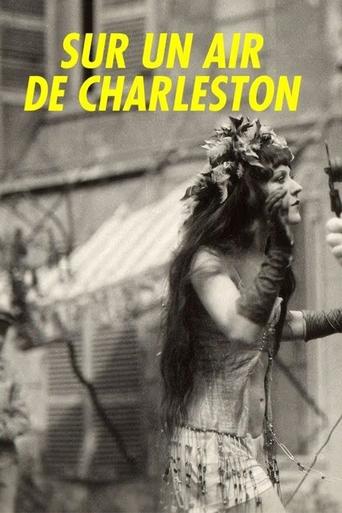tieman64
"Charleston Parade" is a 1926 silent, short film by director Jean Renoir. Set in the year 2028, the film sees a pilot in blackface and minstrel attire leaving a futuristic, high-tech Africa and flying to a primitive, post-apocalyptic France.When our pilot lands, he meets an attractive, scantily clad woman. She's a carnal creature who throws her body at the unsuspecting pilot, who in turn shyly rejects her advances. The woman then begins to communicate with the pilot using dance, scenes which anticipate Renoir's own "French Cancan" (1954).Though dismissed as a silly film, "Charleston Parade" abounds with interesting reversals. Renoir flips white and black stereotypes by assigning frenzied, tribal movements to whites (and a pet monkey no less) and dandyish behaviour (and sexual timidness) to the pilot. The pilot is himself played by Johnny Huggins, a black man, yet one who wears blackface paint, reversing the racist implications of minstrel shows. The film then ends with the pilot taking the primitive white girl back to Africa, where she will reintroduce white aboriginal dance to a people who have lost their own art-form by dint of distance from their ancestors. But while the film parodies white/black historical relations, it also points to common bonds. For Renoir, dance rather than film constitutes a shared language and perhaps also the chief art form from which cinema sprang.Incidentally, the 1920s saw the birth of new African-American communities in Paris. After WW1 ended, many African American GIs decided to stay in France, which lacked the widespread racism of the United States. It was also around this time that jazz was introduced to the French, as well as other aspects of black culture. Pretty soon African American musicians, artists and Harlem Renaissance writers began flocking to Paris – the city's Luminous Years – an exodus which WW2 promptly stopped.9/10 - Even minor Renoir is good Renoir.
Adrian Sweeney
I just found this as an extra on a DVD of 'Grand Illusion.' A surreal, silent, sci-fi short from 1927, it is the tale of a 21st-century African airman who journeys to post-apocalyptic Paris and discovers the sacred dance of the ancients, the Charleston. Hilarious, delightful, sexy, and utterly, utterly, soul-refreshingly bonkers, the maddest thing I have seen in ages.Now I am told my comment is not long enough, which is absurd. There is nothing more to add, except watch out for the Angel-heads. Also, lazy advertising men who are tempted to rip off the angel-heads for some moronic commercial should be informed that someone already did so years ago. I believe that is my ten lines now.
ackstasis
I enjoy science-fiction just as much as the next man… but what the hell was that? Apparently shot over just three days using excess film stock left over from his previous film, 'Nana (1926),' this Jean Renoir short is a bewildering futuristic satire, produced on a budget that couldn't have been much more than zero. In the year 2028, following a great war, Africa has become the most civilised region on Earth, and what was formerly Europe has been designated "Terres Inconnues (Unknown Land)." An African explorer – played by Johnny Huggins, a Black man dressed up as a White man dressed up as a Black man, if you follow me – travels to the ruins of Paris in his spherical aircraft, and lands outside the lair of a Parisian savage (Catherine Hessling, then the director's wife) and her primate companion, perhaps the creepiest ape-man costume I've ever seen. The savage, as part of some bizarre sexual initiation ritual, starts showing the explorer the Charleston dance, which he is delighted to learn himself.It doesn't help the film that Hessling, who was wonderful the following year in Renoir's 'The Little Match Girl (1928),' isn't much of a dancer, though the extensive use of slow-motion adds a touch of surrealism to the ceremony. Furthermore, I'm quite shocked that Renoir would exploit his own wife as such a blatant sexual object – it doesn't come as a surprise to learn of their divorce just three years later! On the plus side, I did like the general sci-fi concept behind the film, and the slyly satiric touch of the reversing the racial roles usually typical in such stories as this. However, why Renoir decided to dress up his Black actor as a minstrel will remain a mystery for all of time. Silly, crude and quite pointless, 'Charleston Parade (1927)' is a cinematic oddity from one of cinema's most respected directors, and is perhaps an effort that he would have liked to forget. The DVD version came without a musical soundtrack, but I compromised with a selection of pieces from Dmitri Shostakovich.
Michael_Elliott
Charleston Parade (1927) ** 1/2 (out of 4) Extremely bizarre short film from Jean Renoir is somewhat sci-fi and somewhat musical. A man in blackface takes off in a spaceship and lands in an unknown country. In this country he meets a white woman (Catherine Hessling; the director's wife) who does a tribal dance, which the blackface man believes is from his native people. I'm really not sure what the hell this film is suppose to be about but I can only guess it has something to do with reverse racism. There are several racial comments made by the white girl and her "not liking black meat" and I guess her being the "native" doing a tribal dance was the reverse thing from the black man doing it, which is something we've seen in countless films from this period. The DVD doesn't feature any music score so it was somewhat hard to know the nature the director was going for. An interesting short to say the least.


